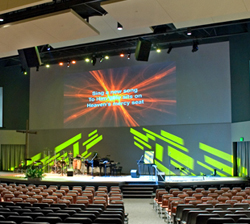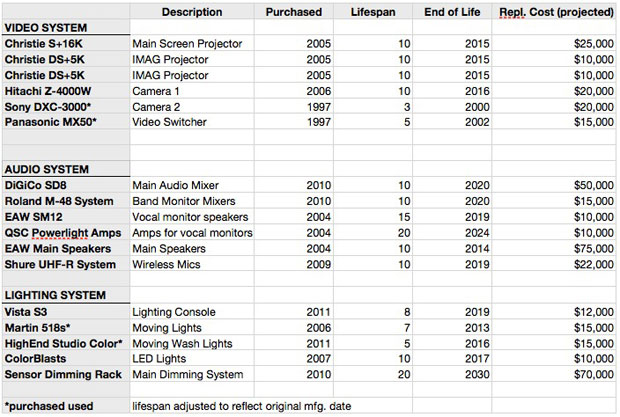I’ve been thinking about the end of life lately.
Not my end of life, mind you, but our equipment’s end of life.
Over the last few years, I’ve been working on replacing all the outdated, worn out and incorrect equipment at Coast Hills (which is just about everything).
I figure this process will take another 3-5 years at least. However, every piece of equipment has a fixed lifespan; stuff just doesn’t last forever.
That means that even the nice, shiny new equipment I’m putting in today will need to be replaced. And I’m not sure anyone ever considers that.
See, I think most churches look at A/V/L equipment as a one-time capital expense. They buy all the stuff they need once, and forget about it for a long, long time. At least until it breaks. At which point there is a sense of panic and urgency to get it fixed or replaced.
As part of my master plan for A/V/L equipment, I’ve decided to run some end of life projections. The rationale is simple; while I know we have a lot of outdated gear to replace right now, we have a bunch of other stuff that will be needing replacement starting in about, oh, 3-4 years.
And when you start looking at the numbers, it’s not chump change. Take a look:
As you can see, we’re talking some serious dollars. Now, I’m just considering major systems; that is systems that have a price tag over $10,000.
I figure the smaller stuff will just get rolled into the normal yearly operating budget. We will always have mics, DIs, single light fixtures and maybe even a video monitor or two to replace.
But when it comes to the big stuff, we need to think that out in advance. And here’s why:
Over the next 10 years or so, we’ll need to spend almost $300,000 to keep pace with our equipment’s end of life. Think we should start planning for that? Uh, yeah.
And this is where it gets tricky. We can’t clearly define “end of life.” Not all equipment will just drop dead at 10 years old. However, we do know that all electro-mechanical devices will begin failing at some point. I’m taking some educated guesses as to when our systems will need replacing.
I’m guessing at roughly how much it will cost (in today’s dollars, anyway), based on equipment I know that is roughly comparable today. Obviously, there are a ton of variables in this plan, but it’s a best guess, Mr. Sulu.
It’s important to keep in mind that these are not budgets, they’re not completely spec’d out systems and I won’t be held to these numbers.
Rather, it’s an estimate for planning purposes. Certainly we may be able to stretch some of the equipment life to even out the graph.
We’re really heavily loaded in the next 2-3 years, then it tapers off until the early 2020’s. As I get into this more, I will probably make some adjustments to see if we can level that out some.
But there’s no getting around it, we need to start setting aside some significant cash right now to be prepared for this.
Either that, or we make some significant decisions regarding our use of technology. For example, we’re looking at some changes to our main auditorium that may negate the need for IMAG. If that’s the case, we can save about $75,000. Not bad.
On the other hand, if leadership decided we not only need to do IMAG, but add a few cameras to the mix, the numbers go up.
So as you can see, this is but a starting point. But without a starting point, we have nothing to talk about. With this, we can start thinking ahead and plan wisely.
How are you planning for your systems’ end of life?
Mike Sessler is the Technical Director at Coast Hills Community Church in Aliso Viejo, CA. He has been involved in live production for over 20 years and is the author of the blog, Church Tech Arts . He also hosts a weekly podcast called Church Tech Weekly on the TechArtsNetwork.
























